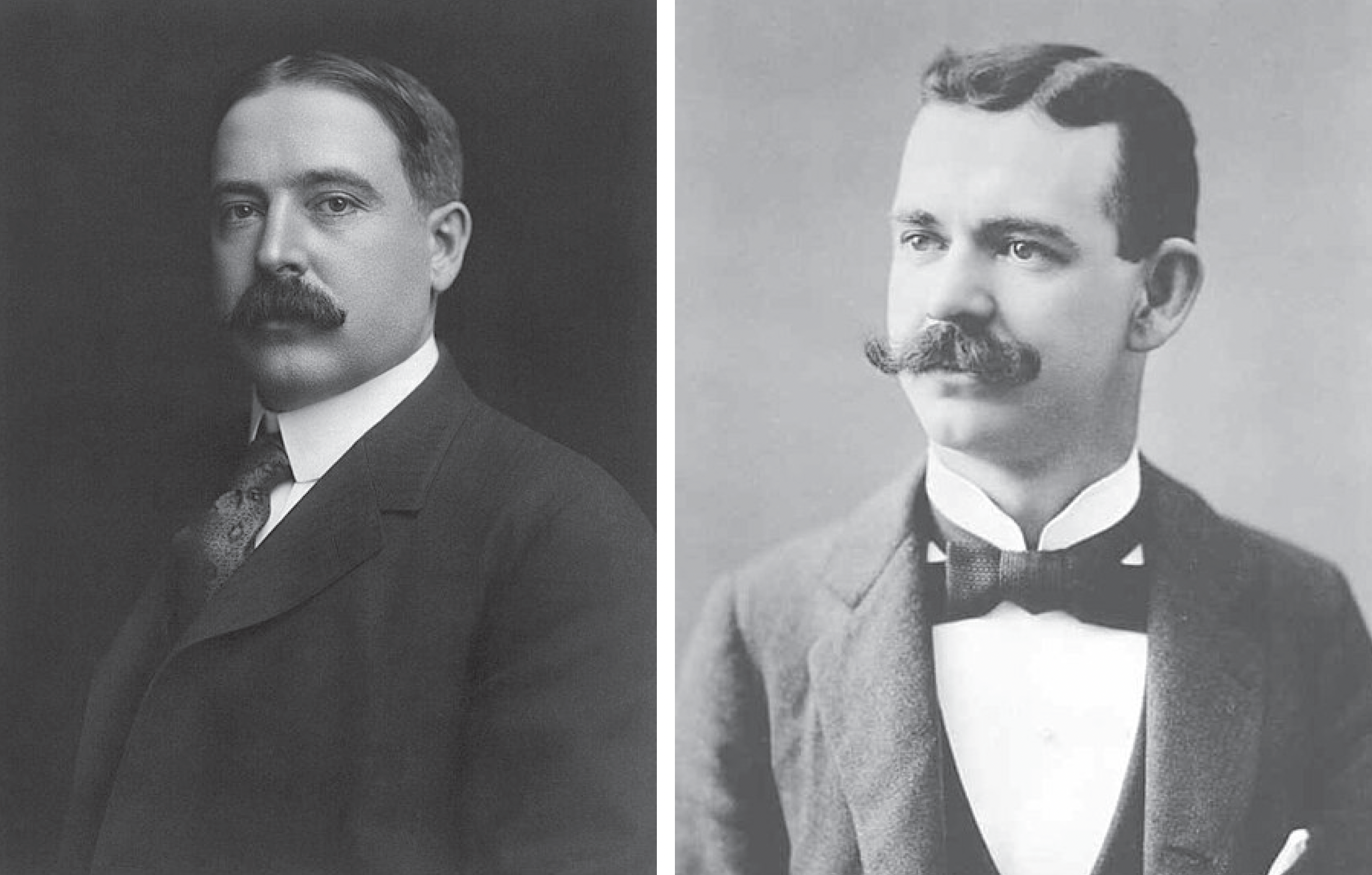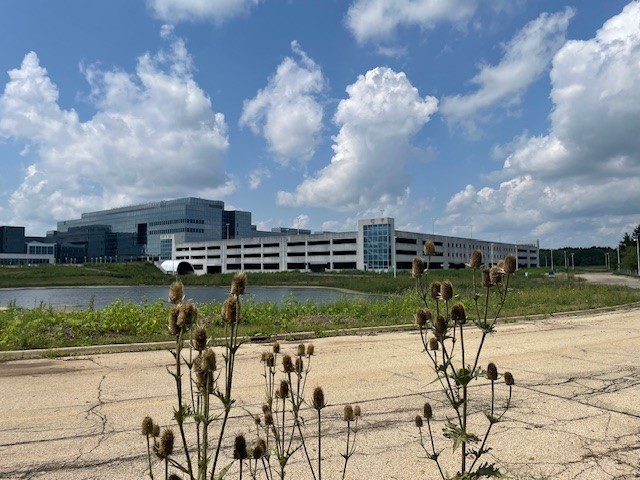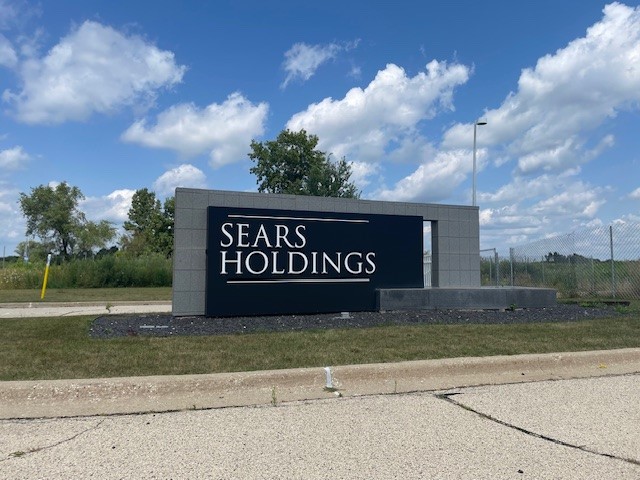The second notable Midwest commercial real estate project we’re going to profile in our CRE Spotlight series is the redevelopment of iconic retailer Sears’ former corporate campus in Hoffman Estates, IL into a massive datacenter park, a project that got underway in June 2024 and is expected to take several years to fully complete.
The Early History of Sears, An American Retail Icon

Richard W. Sears (left) and Alvah C. Roebuck (right).
Sears, Roebuck & Company, which for many years held the title of world’s largest retailer, and whose namesake headquarters tower in downtown Chicago was once the world’s tallest building, began as a humble mail order watch company founded by Richard W. Sears and Alvah C. Roebuck in Chicago in 1893.
In 1895, Julius Rosenwald, a Chicago clothing merchant, became a partner in the thriving company, expanding its product line as well as the territory it served. Sears, Roebuck & Company’s burgeoning merchandise catalog, originally named The Book of Bargains, combined with the rapid growth of the railroads and government expansion of mail routes, helped the pioneering merchant expand into and dominate rural retail markets. In 1895, the company’s annual sales were approximately $750,000.
In 1906, to support its operations, Sears built new offices and a massive, 3 million square foot distribution center in the Homan Square neighborhood on Chicago’s west side. An illustration of the expansive red-brick complex graced the back cover of the Sears, Roebuck & Company catalog for many years. By 1907, the company’s annual sales had soared to $50 million.
Sears Opens Its First Department Store
In 1925, Sears opened its first brick and mortar department store, also located in Chicago, followed by a push by General Robert E. Wood, who had joined the company from competitor Montgomery Ward, to open physical stores outside of urban centers. By 1929, Sears, Roebuck & Company operated 300 department stores in addition to its thriving catalog operation.
Sears’ business strategy was to sell durable consumer staples and provide good value to customers as opposed to focusing on current fashion, as many of its department store competitors did at the time, a strategy that paid off as the country plunged into the Great Depression and consumers sought to squeeze the most from every penny. While countless merchants went out of business during the depression, Sears had doubled its store count by the time it ended.
Sears Expands into Shopping Malls, Internationally
After WWII, Sears began opening stores in suburban shopping malls, the new center of local economic activity, in earnest. It also began expanding into international markets, opening its first store in Mexico in Mexico City in 1947 and partnering with a Canadian mail-order firm on its first store in Canada in 1952. By the mid-1950s, Sears operated over 700 department stores and had become a standard shopping mall anchor, along with its competitor JC Penney. By 1969, Sears had become the world’s largest retailer, with over 3,500 stores.
Sears Begins to Flounder
Then, in the 1970s, Sears’ fortunes began to fall, the start of a long, slow, severe decline for the ubiquitous retailer. The soaring inflation endemic to the decade split the retail market in two. Budget-conscious consumers flocked to low-price retailers like Target, Kmart—which would later become Sears’ parent—and Walmart, all of which were founded in 1962. More affluent customers, who were less impacted by high prices, continued shopping at the more upscale department store chains, leaving Sears floundering somewhere in the middle, searching for its niche. Still, in 1975, Sears, JC Penney and Montgomery Ward together accounted for 43% of all US department store sales.
The Sears Tower
In 1974, Sears moved its headquarters from Homan Square to the soaring, 110-story Sears Tower in downtown Chicago, then the world’s tallest building. In the 1980s, Sears continued to lose market share and eventually then competitor Kmart dethroned it as the world’s largest retailer. In the early 1990s, Walmart, whose business model was to offer low prices and discounts to undercut traditional department store pricing, surpassed Kmart as the world’s largest retailer, a title that – based on revenue– Walmart still holds today.
A Pivot to Insurance, Financial Services
To right the ship and regain its lost share of the retail market, Sears experimented with different business, marketing and merchandising strategies in the ensuing years. None proved effective, so the company pivoted and began focusing on insurance and financial services, including launching the Discover Card credit card in 1985. By the late 90s, Sears’ credit card programs accounted for 60% of the company’s profits.
Sears Moves Its Headquarters to Hoffman Estates, IL
 In 1992, Sears moved its headquarters again, this time from the Sears Tower and the bustling urban environs of downtown Chicago to a sprawling 273-acre campus in Hoffman Estates, IL, a suburb 30 miles northwest of Chicago. Sears reportedly received $536 million in state and local tax incentives over three decades to both remain in Illinois and move to Hoffman Estates, at the time the largest tax break ever in Illinois for a corporate move. In 1994, after renegotiating its mortgage on its namesake former headquarters and relieving itself of nearly $850 million of debt, Sears, while still nominally owning the building, effectively transferred control of the Sears Tower to AEW and MetLife.
In 1992, Sears moved its headquarters again, this time from the Sears Tower and the bustling urban environs of downtown Chicago to a sprawling 273-acre campus in Hoffman Estates, IL, a suburb 30 miles northwest of Chicago. Sears reportedly received $536 million in state and local tax incentives over three decades to both remain in Illinois and move to Hoffman Estates, at the time the largest tax break ever in Illinois for a corporate move. In 1994, after renegotiating its mortgage on its namesake former headquarters and relieving itself of nearly $850 million of debt, Sears, while still nominally owning the building, effectively transferred control of the Sears Tower to AEW and MetLife.
Meanwhile, on Sears’ shiny new corporate campus, seven interconnected buildings comprising 2.3 million square feet of office space served as headquarters for Sears’ various business units. Amenities included a day care center, dry cleaners and fitness center. The cavernous cafeteria included a Taco Bell. When the massive office complex opened, it was one of the 30 largest structures in the world. At its peak in the 1990s, approximately 9,000 employees worked on site.
Sears and Kmart Merge
Although Sears’ move to new headquarters generated a lot of attention, it did nothing to reverse the retailers’ slumping sales and fading fortunes. In 2005, the beleaguered company merged with Kmart, once one of America’s leading discount retailers, which by then was floundering itself, in an $11 billion transaction engineered by hedge fund manager Edward Lampert. Both retailers became subsidiaries of a new parent company named Sears Holdings; Lampert was Sears Holdings’ CEO.
Sears’ Troubles Deepen
However, even an $11 billion merger couldn’t stop the hemorrhaging. The deal was highly leveraged, and the debt load was too burdensome for the struggling company. In addition, big box competitors like Walmart and Target, which had begun offering groceries, continued to erode Sears’ sales and market share, as did the accelerating shift of retail sales from brick-and-mortar stores to ecommerce.
Consequently, Sears’ sales plunged from $43 billion in 2010 to less than $10 billion in 2017, forcing the company to start closing stores. By the summer of 2017, there were only 1,250 Sears stores left, down from 3,400 in 2006, the year after the merger. By 2017, only 4,000 employees were working at the Hoffman Estates campus, less than half of the peak.
Finally, in 2018, $5.6 billion in debt and no longer profitable, Sears Holdings and with it Sears, Roebuck & Company, the venerable retailer that once symbolized the rise of American capitalism, filed for Chapter 11 bankruptcy protection.
Sears Holdings Purchased by Transformco
Re-enter Sears Holdings CEO and erstwhile hedge fund manager Lampert. After long and complex bankruptcy proceedings, ESL Investments, a company formed and controlled by Lampert, purchased all of Sears Holdings’ assets, including 223 Sears stores and 202 Kmart stores that were still operating, through a bankruptcy auction in 2019.
Shortly thereafter, Lampert moved Sears Holdings’ assets to Transformco, which promptly began closing both Sears and Kmart stores at a rapid clip and selling off valuable assets, including real estate, trademarks and Sears’ home services divisions and Die-Hard auto parts brand, while downsizing corporate operations and staff.
Transformco Puts Sears’ Headquarters Up for Sale
Then, in March 2020, the Covid-19 pandemic struck, upending the entire world. Transformco temporarily closed its once teeming but now nearly empty corporate headquarters and instructed its few remaining employees to work from home. They would never return.
In late 2021, Transformco announced it was selling most of its Hoffman Estate campus, including 194 of the 274 acres and the seven buildings on that parcel, but not 120 adjoining acres of undeveloped land that it also owned. Commercial real estate broker Colliers International began marketing the property in early 2022.
Compass Data Centers Buys Sears’ Headquarters
Reportedly, in early 2023, data center developer Yonder was interested in buying the property and building a data center park there but walked away after having trouble securing financing. Then, in July 2023, The Daily Herald reported that the property was under contract and an unnamed group was performing due diligence on it. That party turned out to be Compass Data Centers, a Dallas, TX based developer of data centers. Compass closed on the property in September 2023, paying $194 million for the property, and announced plans to build its first Chicago-area data center park on the site.
Five Data Centers Planned for the Former Sears’ Corporate Campus
Compass officials say they will eventually build five “hyperscale” data centers on the site, each measuring approximately 250,000 square feet and that the project should generate 1,000 construction jobs and about $10 billion in total investment. The total square footage of the data centers will surpass that of Chicago’s John Hancock Building (now known as 875 North Michigan Avenue) and the Empire State Building.
In June 2024, a ceremony with officials from The Village of Hoffman Estates, Compass Data Centers and ComEd, the local electrical utility who will provide the massive amounts of electricity needed to power the new data centers, was held at the site to mark the start of the years-long project, and demolition of the seven old Sears buildings and other structures on the grounds commenced.
An Up-Close Look at the Redevelopment of Sears’ Headquarters


- In August 2024, a construction fence encircled the entire property.
- Demolition of the buildings on the west side of the complex was underway. The rest of the structures, including the large white parking garage on the east side, looked untouched.
- Appearances can be deceiving, though. Reports are interior work to prep the buildings for demolition began last spring.
- To help ready the vacant buildings for demolition, Compass has donated furniture, office equipment and other supplies from them to local businesses and non-profit organizations.
- While the buildings were being readied for demolition, area first responders used them for training.
- By late October 2024, the buildings that had been on the west side of the campus had been completely razed and the debris removed.
- The land in that section was being graded and new infrastructure was being put in place.
- Compass says the site needs to be completely flat before the data centers can be built, so crushed concrete, stone blocks and asphalt from the west side of the campus will be used as fill on the east side to level out the property.
- Approximately 400 million pounds of debris– 85%-95% of the old materials from the site– will be reused on-site or recycled.
- Demolition is being handled by American Demolition Corporation, a contractor based in nearby Carol Stream, IL. Compass says it selected American Demolition for the work because of its ability to minimize waste and maximize the reuse of materials. In addition, Compass is using AI to help reduce greenhouse gas emissions from the project.
- The north side of the property had been cleared of trees and vegetation, providing a clear view of the remaining buildings. A fleet of earth movers and other heavy equipment was parked just beyond the construction entrance.
- Near the northeast corner of the property, tall piles of sand and crushed concrete sat ready to be used as fill. There were also stacks of large cement drainage pipes waiting to be installed.
- Meanwhile, multiple buildings and structures on the campus’ east and south sides, including the parking garage and auditorium, remained standing and the entrances and roads inside the campus were still intact.
What’s Next for The Former Sears Corporate Campus?
Compass officials say the demolition phase of the project will last about another 12 months and that razing the buildings is a very slow process because wrecking balls and other special equipment must be used due to the height of the buildings, many of which were five or six stories tall.
Above ground construction of the data centers should start around late 2025 and each data center should take 15-18 months to complete, says Compass. The first data center should be online in mid-2026. When all five buildings in the data center park are finished, the facility will be among the 10 largest data centers in Illinois. One client will likely lease all the space. Chicago-based contractor Power Construction will be handling the above ground construction.
Demand For Data Centers Skyrockets
That the old Sears, Roebuck & Company headquarters is being transformed into a data center park is a result of three current and noteworthy trends in commercial real estate: the steady demise of the centralized suburban corporate campus that was so popular decades ago; suppressed demand for office space in general post-Covid; and growing demand for data centers to support AI applications and cloud computing.
With demand for data centers soaring, The State of Illinois is offering data center developers generous enticements to build projects in the state, including exemptions from state and local sales and use taxes and construction credits for some projects. Likewise, Hoffman Estates itself recently rezoned land in hopes of attracting other data centers to the village. Back in 2021, Microsoft announced plans to build a data center in Hoffman Estates, which will give the suburb two major data centers once it and the Compass development on the former Sears site are complete.
More To Come on the Redevelopment of Sears’ Headquarters
As with the other noteworthy Midwest commercial real estate projects we’re profiling in our CRE spotlight series, we’ll be providing updates on the transformation of the former Sears’ corporate campus into a data center park as the project moves along, including photos.
In case you missed it, the first project we covered in our spotlight series was the redevelopment of the James R. Thompson Center in downtown Chicago into Google’s new Chicago headquarters.
Other notable Chicago area commercial real estate projects we’ll be profiling in the future include Northwestern University’s new football stadium and entertainment district and the glitzy new casino and hotel being built on the former site of the Chicago Tribune’s massive printing and distribution plant. If you’re interested in learning more about those projects—and seeing photos—check our blog regularly for new posts.
Expert Help with Your Data Center and Redevelopment Projects
If you’re considering developing, acquiring or selling a data center, Realogic has extensive experience underwriting data center transactions and providing other types of critical support to data center owners and investors.
We’ve also supported numerous redevelopment and value-added repositioning projects and can help with those a number of ways, including with underwriting, due diligence, financial modeling, loan abstraction and closing support.
Or, if you prefer to model your projects yourself, we offer a wide range of accurate, dynamic off-the-shelf Excel models for commercial real estate development and acquisition.
For more information on any of our commercial real estate services or solutions, contact us at info@realogicinc.com or 312-782-7325.
About the Author
Terry Banike is Vice President of Marketing for Realogic. Over the course of his career, he has worked in marketing, communications, journalism and public relations, and has written news stories and features for newspapers, trade publications, newsletters and blogs. A rabid reader of anything and everything on commercial real estate, Terry closely follows commercial real estate news and trends and frequently posts about real estate on the Realogic Blog. He can be reached at tbanike@realogicinc.com.
Sources
- The Rise and Fall of Sears; Vicki Howard, Zocalo Public Square; Smithsonian Magazine; July 25, 2017.
-
Sears Demolition Continues Even as Hoffman Estates Site Begins Prep for Compass Datacenters; Eric Peterson; Daily Herald; November 3, 2024.
-
Sears To Sell Its Suburban Chicago Corporate Headquarters; Associated Press; December 17, 2021.
-
Sears Has Only 12 Stores Left in America; Douglas A. McIntyre; 24/7 Wall St.; December 11, 2023.
-
Closed, Open, Now Closing Again: Sears’ Vanishing Store Footprint Claims WA State Site; Debbie Cockrell; The News Tribune; August 15, 2024.
-
The Rise and Fall of Sears, Once the Largest and Most Powerful Retailer in the World; Erin McDowell; Business Insider India; January 24, 2020.
-
Sears’ Longtime Headquarters Near Chicago Sold to Data Center Developer for $194 Million; Ryan Ori; CoStar News; September 15, 2023.
-
Sears Headquarters Sold to Compass Datacenters for $194M; TRD Staff; The Real Deal; September 17, 2023.
-
Compass Kicks Off Development of Its First Hyperscale Data Center Campus in Illinois; Compass Datacenters Press Release; June 13, 2024.
-
Demolition of Iconic Sears Complex Starts, Opening A New Era for High-Tech Industry; Brian J. Rogal; Chicago Tribune; September 3, 2024.
-
Hoffman Estates Ready for A ‘Modern Era’ with Data Center Project at Former Sears Site; Abby Miller; Chicago Sun-Times; June 13, 2024.
-
Data Center Developer Compass to Buy Sprawling Former Sears Campus; Katharine Carlon; Bisnow; July 20, 2023.
-
Demolition Under Way at Old Sears Headquarters in Hoffman Estates, Illinois; Adam Harrington; CBS Chicago; August 16, 2024.
-
Sears Tower To Be Sold, But Tallest Building to Keep Name; Seattle Times Staff; Seattle Times News Services; November 8, 1994.
-
Attention Shoppers: Last Full-Sized Kmart in Continental US Closes As Retail Giant Fades; James Powel; USA Today; October 20, 2024.
-
Attention Kmart Shoppers: The Last Full-Size Kmart in The Mainland United States Is Closing; Chris Isidore; CNN Business; September 23, 2024

